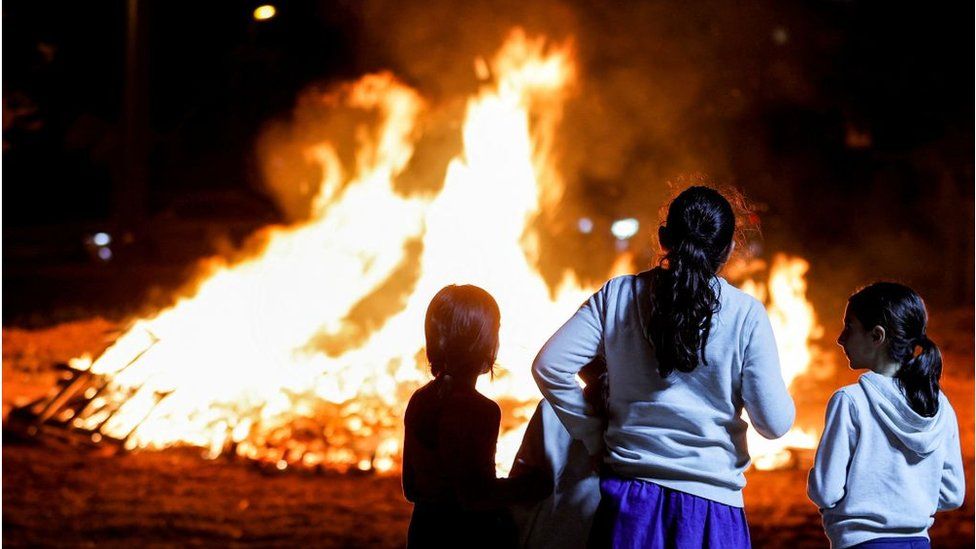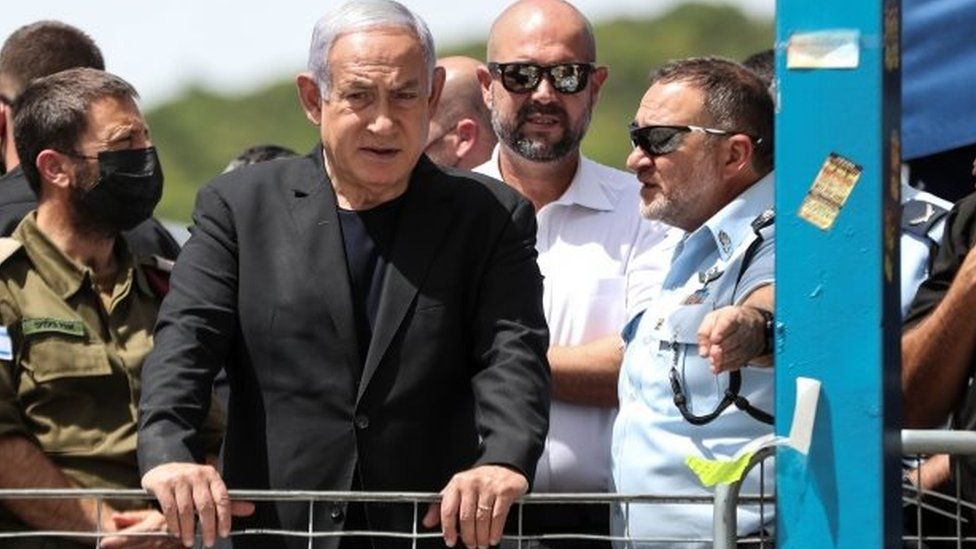RELIGIOUS leaders pressured organisers not to limit numbers at a festival in Israel before 45 people were crushed to death, say shock reports.
Dozens died when panicked crowds funnelled into a tiny "death trap" tunnel at a high-profile Jewish festival late on Thursday night.
The country's worst peacetime disaster unfolded at the overcrowded festival of Lag B'Omer in Meron.
Now it's been been suggested religious leaders put pressure NOT to limit numbers - as it emerged more than 100,000 people eventually turned up.
Reports had previously warned large numbers posed a "danger to human life" and suggested that capacity should be capped at 15,000.
Sources, however, told reporters from Israeli Channel 13 that ministers had allegedly asked local cops to ensure large numbers would be able to enter.
That move was in an effort to make up for the cancellation of last year's event during the pandemic, the Times of Israel reported.
The head of the Shas religious political party allegedly wrote to Public Security Minister Amir Ohana saying "anyone who wants to come [to Meron] should be allowed to do so."
It is alleged that Ohana then approved that request so no limits were placed on the number of attendee.
One source reportedly said: "It's the greatest mass gathering in Israel. In no other event does the political pressure on police come close to the amount of pressure [brought forth] to hold the Meron event."
Tens of thousands eventually packed onto Mount Meron for the largest gathering held in the country since the Covid outbreak began.
The chaos reportedly ensued when attendees slipped on a narrow metal walkway as thousands tried to leave - causing the deadly crush as bodies piled into each other, injuring at least 150, some critically.
The first funerals have now taken place for the victims in the wake of the stampede.
Devastated families have been identifying their loved ones and buried them ahead of the Jewish Sabbath that began on Friday evening.
Two pairs of young brothers were among those killed in the tragedy.
Yosef and Moshe Elhadad, aged 18 and 12, from northern Israel, and Moshe and Joshua Englander, aged 14 and nine, from Jeruselum were all killed.
Others who lost their lives in the stampede were Yosef Amram and Eliezer Tzvi Yoza'af, 26, from America, father-of-11 Shimon Matalon, 38, and Shragee Gestetner, a rabbi and singer from Montreal.
Her Majesty Queen Elizabeth sent a message of condolence to the country, after being "deeply saddened" by the incident.
She added that her thoughts were with the families of those who lost their lives.
The Queen's letter, addressed to the country's president Reuven Rivlin, wrote: "I was deeply saddened by news of the disaster at the Lag B'Omer festival in Meron, Israel.
"My thoughts are with all those who have been injured, and the friends and families of those who lost their lives. They have my deepest sympathies. Elizabeth R."
An early police investigation revealed that the slip created a "human avalanche", Ynet news reported.
Witnesses claimed cops blocked the exit - and a police chief has admitted that the tunnel was dangerous.
A survivor named David told Ynet: "Our bodies were swept along by themselves. People were thrown up in the air, others were crushed on the ground.
“There was a kid there who kept pinching my leg, fighting for his life. We waited to be rescued for 15 to 20 minutes in this crazy, terrible crush. it was awful.”
Meir, who was injured in the crush, told Ynet from his hospital bed: “It felt like an eternity, the dead were all around us.
Eli Beer, the head of the Hatzalah rescue services organisation, said young children were among the victims.
“To my sorrow, we found small children who had been crushed, we tried to resuscitate them and managed in a few cases to save them,” he said.
“We have to wake up, it’s shocking how many people were allowed to enter."
Only 10,000 people were supposed to attend the event but a crowd of 100,000 turned up.
Eli Pollack, the head of the United Hatzalah emergency rescue service, said the narrow exit was a "death trap".
Shoes, hats, baby strollers, smashed glasses and water bottles were left strewn on the ground in the walkway, while metal railings were ripped from the ground.
Witness Zohar said he saw victims "lose the colour in their faces".
“I was under the bleachers, I tried to go up toward all the chaos when I heard banging above, thud, thud, and people shouting ‘escape, escape, people are dying,'" he said.
“People fell from above and crushed each other, they squashed each other. people just fell, I will never forget the banging sounds, people flying all over."
Zohar added: “We were walking out, everything was flowing, suddenly it stopped.
“Everyone was pressed up against each other and we did not understand why. I lifted up my head and I saw police blocking the entrance, I shouted to them ‘people are dying here.'”
A probe has been launched into the possibility that police negligence caused the stampede.
Northern District Commander Shimon Lavi, who oversaw the security arrangements at the site, said that he took responsibility for the disaster.
“I bear overall responsibility, for better or worse, and am ready for any investigation,” he said.
He added that the exact cause remained unclear.
Investigators have been sent to Meron to gather evidence.
Attorney General Avichai Mandelblit said: “It was decided that the Police Internal Investigations Department will immediately examine whether there are suspicions of criminality by police in the tragedy in Meron.”
Paramedic Dov Maisel described "chaotic" scenes as rescuers desperately scrambled to save as many lives as they could.
He told Good Morning Britain: "I started hearing screaming and shouting... and immediately all the teams were alerted to the scene.
"It's so troubling... many kids and teenagers were injured as well and families separated, it's chaos."
Mr Maisel said attendees were crushed as tens of thousands tried to force themselves through a narrow passageway.
He said: "It's a very small area on the mountain top, and thousands and thousands of people poured into this area, more than we expected.
"There was a bottleneck where people were squashed next to each other as they tried to get to an exit.
"People yelled behind them to stop people pushing through."
He said the disaster reminded him of terrorist attacks.
"I literally had a flashback to 20 years ago when Israel had a terror wave when restaurants and hospitals were being blown up, the scene was the same if not worse," he said.
"This is the worst disaster in Israeli history of a civilian event, this is shocking for the whole country."
What is the Lag B'Omer festival?
LAG B'Omer is a Jewish religious holiday celebrated on the 33rd day of the Counting of the Omer, which began on March 28 and ends on May 16.
The day in the Hebrew month of Iya marks commemorates Rabbi Shimon bar Yochai, who lived in the second century.
The day marks when he revealed the secrets of kabbalah - a school of thought in Jewish mysticism - in the Zohar, or Book of Splendor.
The festival includes the lighting of bonfires, pilgrimages to the tomb of bar Yochai in Meron and customs at the tomb.
Another tradition that makes it a day of celebration is the anniversary of the plague that killed leading Jewish scholar Rabbi Akiva's 24,000 disciples coming to an end around 100AD.
Mr Maisel said 400 paramedics responded to the crush.
Prime Minister Benjamin Netanyahu described the tragedy as a "heavy disaster".
MDA spokesman Zaki Heller told Ynet news that the deaths were caused by severe overcrowding.
The mass gathering took place at the tomb of a 2nd-century sage for annual commemorations when the structure collapsed.
Videos posted on social media showed chaotic scenes as Ultra-Orthodox men clambered through gaps in sheets of torn corrugated iron to escape the crush, as police and paramedics tried to reach the wounded.
Initial reports said a stand had collapsed at one of the concerts - however, rescue services said the tragedy was caused by a crush and overcrowding.
The disaster is one of the worst peacetime tragedies in Israel’s history, matching the death toll from the 2010 Mount Carmel forest fire.
The IDF, which sent its 669 rescue team to the site, said a roof had collapsed at the festival.
A pilgrim at the festival told a local news channel: "We thought maybe there was a [bomb] alert over a suspicious package.
"No one imagined that this could happen here. Rejoicing became mourning, a great light became a deep darkness."
Prime Minister Netanyahu said: "Everyone is praying for the recovery of the injured."
Zaki Heller said that due to the overcrowding, it took some time to help people who had been trapped.
"The rescue teams were called to one of the concerts near Bar Yochai’s tomb, where there was a terrible crush near a building. There were dozens trapped on a nearby stand and it took time to evacuate them," Heller said.
Other videos from the scene showed rescue workers were attempting to set up a field hospital - and dozens of ambulances could be seen trying to navigate through the huge crowds.
Reports indicate that around 100,000 people may have been attending the night's events, despite health officials warning that people should not gather in large crowds even as Covid cases were plummeting across Israel.
Around 5,000 police were deployed to secure the event, with the cops urging pilgrims to avoid incidents during the feast when bonfires are lit.
The country has seen Covid cases plummet since launching one of the world's most successful vaccination campaigns late last year.
The tomb is also considered to be one of the holiest sites in the Jewish world and it is an annual pilgrimage site.
https://news.google.com/__i/rss/rd/articles/CBMiW2h0dHBzOi8vd3d3LnRoZXN1bi5jby51ay9uZXdzLzE0ODIzMzA2L2lzcmFlbC1zdGFtcGVkZS1yZWxpZ2lvdXMtbGVhZGVycy1ub3QtbGltaXQtbnVtYmVycy_SAV9odHRwczovL3d3dy50aGVzdW4uY28udWsvbmV3cy8xNDgyMzMwNi9pc3JhZWwtc3RhbXBlZGUtcmVsaWdpb3VzLWxlYWRlcnMtbm90LWxpbWl0LW51bWJlcnMvYW1wLw?oc=5
2021-05-01 13:25:00Z
52781553577023

























 The body of a COVID victim is kept on a funeral pyre before last rites are performed [Anindito Mukherjee/Getty Images]
The body of a COVID victim is kept on a funeral pyre before last rites are performed [Anindito Mukherjee/Getty Images]







 A private security guard stands outside an empty vaccination centre after Mumbai’s municipal body issued a notice about no vaccinations for three days [Francis Mascarenhas/Reuters]
A private security guard stands outside an empty vaccination centre after Mumbai’s municipal body issued a notice about no vaccinations for three days [Francis Mascarenhas/Reuters] Indian ground staff unload coronavirus relief supplies from the US at the Indira Gandhi International Airport cargo terminal in New Delhi [Prakash Singh/Reuters]
Indian ground staff unload coronavirus relief supplies from the US at the Indira Gandhi International Airport cargo terminal in New Delhi [Prakash Singh/Reuters]








